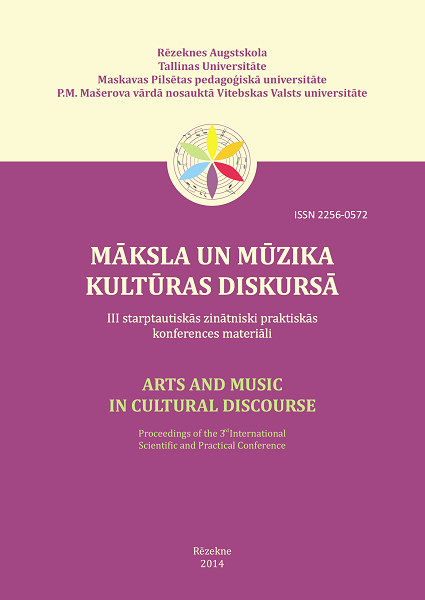Fugue in Sacred Vocal-instrumental Compositions of Latvian Composers
DOI:
https://doi.org/10.17770/amcd2014.1343Keywords:
polyphony, fugue, sacred music, sacred music genres, latvian composersAbstract
The aim of the article is to familiarize with the use of fugue and other fugue-type forms in sacred vocal-instrumental compositions of Latvian composers. The usage of fugues and other related forms in the contemporary sacred music genres is predetermined by the historical tradition. Already since the baroque era one of the most important constructive components of sacred vocal-instrumental compositions is fugue. As regards the Latvian music, the fugue has presented itself forthe first time particularly in the sacred vocal- instrumental composition. Namely the Garīgā kantāte (Sacred Cantata, 1887) by Andrejs Jurjans. After A. Jurjans other composers have used fugue in their sacred vocal-instrumental music: Viktors Bastiks in Requiem (1979), Romualds Kalsons in oratorium Petrus (1993), Rihards Dubra in cantata Canticum fratris solis (1997), Romualds Jermaks in Requiem (2002), Ilona Brege in Requiem (2010) etc.References
Alberings, A. (1992). Kora skaņdarbu latīņu tekstu tulkojumi. Rīga: Latvijas Republikas Kultūras ministrijas Skolu centrs.
Beiche, M. (1996). Fuga / Fuge. In Terminologie der Musikalischen Komposition. Hg. Hans Heinrich Eggebrecht, sonderband II. (s. 103-144). Franz Steiner Verlag: Stuttgart .
Jorgensens, J. (1998). Svētais Asīzes Francis. Rīgas Metropolijas kūrija.
Walker, Paul. (2001). Fugue. In The New Grove Dictionary of Music and Musicians / Second Edition. Edited by Stanley Sadie. Executive Editor John Tyrrell. Vol. 9. (p. 318-332). London: Macmillan Publishers Limited.
Дубравская, Т. (2008). Полифония: учебник для высшей школы. Mосква: Академический Проект, Альма Матер.
Крупина, Л. (2001). Эволюция фуги. Москва: Издательство РАМ им. Гнесиных. 7. Фраенов, В. (1987). Учебник полифонии. Москва: Музыка.






